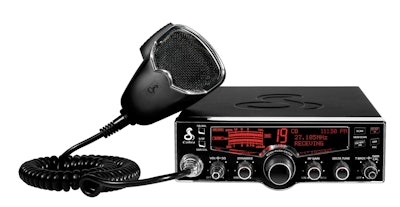A not-so-modest proposal from licensed ham operator and truck driver for breaking the Channel 19 cacophony

“Is the CB becoming obsolete? H___ NO!” he wrote. Selase contends that, more than cell phones, with their unpredictable connectivity; more than so-called “smart” phones plagued by the same problems as their simpler cellular cousins; more than any laptop you can buy, the CB is the crucial personal communication tool of any long-haul driver. Whether you use yours is one thing, but “some don’t even have a CB,” he says. “I think that’s the biggest mistake you can make out here.”
When Selase came on the road in 2004 with U.S. Xpress, he “had no idea” about what a CB radio even was. “My first assignment out was myself and two other drivers doing hurricane relief – delivering water and another necessities,” he says, on which trip he spent what little money he had to buy a Cobra 29. His interest in radio communications spiked over the years when he started hearing about longer-range single sideband (SSB) radios that could allow long-distance communication from the cab over the airwaves. Today, Selase is a licensed ham operator, and he takes it upon himself to help other drivers parse the murky legal terrain that using the more powerful SSB radios can put them in.
But it’s another issue that’s taken his attention lately, one touched on in the July Truckers News story. Selase understands the problems so many have with the overcrowded, sometimes vulgar nature of Channel 19. He’s on a mission to change that by promoting the use of other bands among the long-haul public. Specifically, Selase says, “for emergencies, detours, hazardous driving conditions and other situations that may arise” channels 3, 13, 23 and 33 are generally available for public use. “I’m trying to get these channels used as consistently and often as people use 19 – I’m stepping on some truck drivers’ toes by doing this, with people saying that it’s a bad idea, Channel 19 is there for our use and open to everybody.”
But Selase is quick to point out that, as others have suggested, “clearly everybody is not welcome to use that channel.
“We have a lot of immigrants who are driving trucks – Bosnians, Russians, Africans. They feel unwelcome at times.” Selase says he’s well familiar from his past travel around the world in the army with “how it is feeling left out. A Mexican comes on Channel 19 and speaks Spanish, for instance. A certain category of Americans immediately becomes obnoxious, and I don’t like that. So what I would like to do is make them feel that they should always be welcome to use channels other than just 19.”
With the uptick in use of alternate channels might come an uptick in safety on U.S. highways, as Selase feels the absence of CBs for some haulers presents significant safety challenges. Depending on the degree of Selase’s success at convincing you, time, as they say, will tell.
Posted
A recovery of one’s own Fort Gratiot Express owner-operator Cliff Hagedon was featured in August on the WNYC radio program Takeaway in a segment on economic indicators with a human face behind them. Hagedon noted increasingly favorable ratios of available trucks to available loads on public load boards as evidence that the economic slump was beginning to improve for him. To consider that indicator industry-wide as positive is tough, given that perhaps the most key element therein is the dramatic reduction in available truck numbers, or capacity – or fleets and owner-operators going out of business, however you want to look at it. But for those still active in the industry, it could mean, as Hagedon suggested, that business prospects have at least improved since last year.
I recently concluded an informal test of economic activity of my own, one you might remember from this column’s July edition. A few mornings a week I counted trucks headed eastbound on I-20/59 in Alabama between milemarkers 90 and 100 as I moved westbound on the same route, from mid-May to the end of July. What I found was a slowly increasing number of Class 8s making moves during that period (see graph), increasing from an average 53 trucks the first full week of June to an average 71 the last full week of July. Though the picture from officialdom is for continuing soft freight, you might take heart from these more personal indicators.







